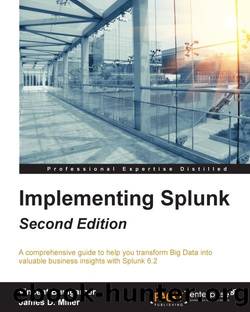Implementing Splunk Second Edition by Second Edition

Author:Second Edition [eBook]
Language: eng
Format: mobi, epub
Publisher: Packt Publishing
Stepping through the param instances, we have the following terms and their descriptions:
field: This is the label for the field displayed in the dashboard.
replacementMap: This parameter names the variable that the ExtendedFieldSearch module is creating. I have been told that the nested nature means nothing, and we should simply copy and paste the entire block of XML, changing nothing but the value of the deepest param tagâin this case to user.
intention: Intentions have specific structures that build blocks of query from a structured XML. In the case of stringreplace (which is the most common use case), we can essentially copy the entire XML and, once again, change nothing but the value of the third-level param, which is currently user. The fillOnEmpty value determines whether to make the substitution when the user variable is empty.
All of this code simply tells us to replace $user$ in any searches with the value of the input field. Our first HiddenSearch value looks like the following:<module name="HiddenSearch" ... <param name="search"> sourcetype="impl_splunk_gen" loglevel=error user="$user$" | timechart count as "Error count" by network </param>
Download
Implementing Splunk Second Edition by Second Edition.epub
This site does not store any files on its server. We only index and link to content provided by other sites. Please contact the content providers to delete copyright contents if any and email us, we'll remove relevant links or contents immediately.
| Access | Data Mining |
| Data Modeling & Design | Data Processing |
| Data Warehousing | MySQL |
| Oracle | Other Databases |
| Relational Databases | SQL |
Algorithms of the Intelligent Web by Haralambos Marmanis;Dmitry Babenko(16236)
Azure Data and AI Architect Handbook by Olivier Mertens & Breght Van Baelen(7676)
Building Statistical Models in Python by Huy Hoang Nguyen & Paul N Adams & Stuart J Miller(7658)
Serverless Machine Learning with Amazon Redshift ML by Debu Panda & Phil Bates & Bhanu Pittampally & Sumeet Joshi(7531)
Driving Data Quality with Data Contracts by Andrew Jones(7294)
Data Wrangling on AWS by Navnit Shukla | Sankar M | Sam Palani(7291)
Machine Learning Model Serving Patterns and Best Practices by Md Johirul Islam(7032)
Learning SQL by Alan Beaulieu(6239)
Weapons of Math Destruction by Cathy O'Neil(6220)
Big Data Analysis with Python by Ivan Marin(5937)
Data Engineering with dbt by Roberto Zagni(4933)
Solidity Programming Essentials by Ritesh Modi(4567)
Time Series Analysis with Python Cookbook by Tarek A. Atwan(4402)
Pandas Cookbook by Theodore Petrou(4088)
Blockchain Basics by Daniel Drescher(3544)
Natural Language Processing with Java Cookbook by Richard M. Reese(3146)
Hands-On Machine Learning for Algorithmic Trading by Stefan Jansen(3049)
Learn T-SQL Querying by Pam Lahoud & Pedro Lopes(2931)
Feature Store for Machine Learning by Jayanth Kumar M J(2928)
